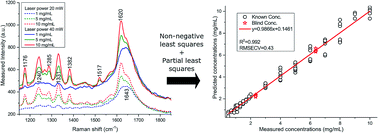A fast and novel internal calibration method for quantitative Raman measurements on aqueous solutions
Abstract
In this study, aqueous paracetamol solutions were measured with varying experimental parameters (i.e., laser power and exposure time) using Raman spectroscopy. The solvent Raman spectrum peaked at 1643 cm−1 (i.e., OH bending vibration mode of water) acts as an internal reference signal for quantifying the concentration of paracetamol. Paracetamol and water have overlapping Raman bands which complicate the quantification. Non-negative least squares fitting was used to extract the water Raman spectrum, which overlaps with the two strong paracetamol vibration modes at 1620 and 1660 cm−1. The variations in the Raman intensities of paracetamol solutions due to the experimental variabilities were thus eliminated through normalization with the extracted water Raman spectrum. Based on the normalized spectra of paracetamol solutions, a partial least squares calibration model for quantification of paracetamol concentrations was developed, resulting in a root mean square error of cross-validation of 0.43 mg mL−1 and a linearity of R2 = 0.992. The model was cross-validated using two blind samples, yielding a root mean square error of prediction of 0.11 mg mL−1. The findings of this study demonstrated that Raman spectroscopy in combination with a simple, fast and novel internal calibration method using non-negative least squares and partial least squares can be used to quantify active pharmaceutical ingredients in solution in spite of the overlapping solute and solvent signals and variations in experimental parameters.

- This article is part of the themed collection: Analytical Methods Recent HOT articles


 Please wait while we load your content...
Please wait while we load your content...